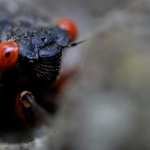
reuters.com - Photography by Carlos Barria. Reporting by Andrea Januta -26-05-2021
Wooded areas up and down the U.S. East Coast are breaking into a deafening buzz.
After 17 years spent alone underground, billions of red-eyed cicadas are emerging for their final act: to meet a partner, breed and die.
Upon emerging, the insects blanket the trees and ground -- with the males filling the air with buzzing and whistling to attract females. But that sound also brings tourists and scientists to study this rare event. With air temperatures and surface soils warming from climate change, scientists are also keen to learn how the creatures are responding.
Temperatures affect when cicadas emerge and their underground growth. Scientists witnessed large numbers of 17-year cicadas surface years ahead of schedule in 2017, which entomologists suspect could be related to global warming.

"The biggest questions are: Is climate change changing their life cycles? And then, how does it change them?" said Chris Simon, an evolutionary biologist at the University of Connecticut who has studied the insects for more than three decades.
Temperatures affect when cicadas emerge and their underground growth. Scientists witnessed large numbers of 17-year cicadas surface years ahead of schedule in 2017, which entomologists suspect could be related to global warming.
"The biggest questions are: Is climate change changing their life cycles? And then, how does it change them?" said Chris Simon, an evolutionary biologist at the University of Connecticut who has studied the insects for more than three decades.
Along with her husband, Simon has spent most of May driving around the U.S. East Coast, chasing online reports of this year's brood emerging in order to map out the precise range. Her husband, oceanographer Stephen Chiswell, often partners with her during cicada trips and has published with her on the topic. As they crisscross cicada territory, Simon keeps the car windows down so she can listen for the telltale singing.
Her chase is being helped this year by tens of thousands of citizen scientists uploading photos of cicadas along with coordinates to an online platform called Cicada Safari app, developed by Gene Kritsky, dean of behavioural and natural sciences at Mount St. Joseph University.
The 17-year cicadas emerging this year make up Brood X (pronounced "Brood Ten"), one of the largest periodical cicada broods. Other periodical cicada broods show up every 13 or 17 years in other regions of the country, and still other cicadas emerge annually.
Simon has coordinated with other scientists to map their full range and has kept to smaller, country roads where traffic will not drown out the cicadas' sound, particularly that of the most common -- and quieter -- species, Magicicada Septendecim.
"It's kind of a lower pitch, more mellow, and you can't really hear it when you're on a highway," Simon said.
When she finds the place where the singing has stopped, she backtracks to where she last heard it and logs the coordinates.
A FEW WEEKS ABOVE GROUND
The cicadas singing today are the offspring of insects that emerged in 2004. Facebook had launched just months earlier. Greece was gearing up to host the Olympics. And George W. Bush and John Kerry were vying for the U.S. presidency.
After cicadas pair and mate, the female carves grooves into a tree, where she lays hundreds of rice-shaped eggs.
In some areas in recent decades, early groups are getting bigger and surviving longer. The early Brood X cicadas in 2017 showed up in larger numbers than ever recorded.
Scientists have a hypothesis for how climate change might be disrupting the insects' internal clocks. While underground, cicadas receive chemical signals from trees through the sap they feed on -- signals that may help the insects mark time. When trees burst into leaves in the spring, the pace of cicadas' development picks up, then it slows again in winter as leaves fall to the ground.
Soon after the eggs hatch, the larvae fall to the ground and burrow into the earth. They dig out solitary chambers and begin growing as they feed on tree sap until it is time to re-emerge and repeat the cycle.
Some insects pop up four years too early or late. That has led Simon and other scientists to suspect the insects somehow track when four years have gone by -- a mechanism that could be disrupted by climate change.

But climate change is shifting these growing seasons. "As the climate gets warmer, you get a longer growing season. And if you get a longer growing season, the cicadas can get bigger every year," Simon says. "So there's more ready to come out four years early."
While mapping their territory, Simon is also capturing cicadas for DNA sequencing, to compare genetic markers with specimens from other life stages to look for clues as to how they track time.
With a better understanding of how cicadas know when to emerge, scientists may be able to solve whether and how climate change is having an impact, Simon said. Eventually, we could see 17-year cicadas "escape through time" and permanently change to a 13-year cycle.
LONG EVOLUTION A CLIMATE 'HANDICAP'
America's periodical cicadas are no strangers to climate change.
"We think the big swings in climate contributed to the evolution of the seven species that we have now," said John Lill, a cicada researcher and chair of George Washington University's biology department.
There is clear evidence that cicadas were pushed south during the last glaciation event, he said, then expanded their ranges northward again as the Earth warmed.
But today's rapid temperature shifts are "totally different" than the gradual climate shifts of the past, he said. Like with other creatures, "the concern is that it's happening so rapidly that species aren't going to be able to evolve adaptations to keep up with it."
That may be especially true for cicadas.
"These guys are going to be handicapped in a very real sense in their ability to respond to climate change, because of the fact that they have such long generation times," Lill said. "You can only evolve as fast as you can have new generations."



